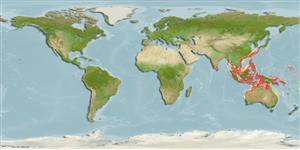>
Callionymiformes (Dragonets) >
Callionymidae (Dragonets)
Etymology: Callionymus: Greek, kallion, comparative of kallos = beautiful + Greek, onyma = name; with a better name .
More on author: Fricke.
Environment: milieu / climate zone / depth range / distribution range
Ecología
marino demersal; rango de profundidad 49 - 148 m (Ref. 42832). Tropical
Indo-West Pacific: Andaman Sea to China, Philippines and New Guinea.
Tamaño / Peso / Age
Maturity: Lm ? range ? - ? cm
Max length : 15.0 cm TL macho / no sexado; (Ref. 42832); common length : 12.0 cm TL macho / no sexado; (Ref. 42832)
Espinas dorsales (total): 4; Radios blandos dorsales (total): 9; Espinas anales 0; Radios blandos anales: 9. Head and body brown, dorsally with many white-edged dark spots. Ventral sides whitish. Sides with 1 or 2 rows of dark blotches. First dorsal fin in males with many irregular white-edged dark lines. Fin distally blackish in females and young males. Second dorsal fin in males with vertical blackish streaks. Anal fin with 8 basal blackish spots. Caudal, pectoral, and pelvic fins spotted with brown (Ref 42832).
Found on sand and mud bottoms (Ref. 42832). Feeds on crustaceans, worms, and snails (Ref. 42832). Utilized as fish meal; sometimes marketed fresh (Ref. 42832).
Life cycle and mating behavior
Madurez | Reproducción | Puesta | Huevos | Fecundidad | Larva
Fricke, R., 2001. Callionymidae. Dragonets. p. 3549-3571. In K.E. Carpenter and V. Niem (eds.) FAO species identification guide for fishery purposes. The living marine resources of the Western Central Pacific. Vol. 6. Bony fishes part 4 (Labridae to Latimeriidae), estuarine crocodiles. FAO, Rome. (Ref. 42832)
IUCN Red List Status (Ref. 130435)
Threat to humans
Harmless
Human uses
Pesquerías: escaso valor comercial
Más información
Nombres comunesSinónimosMetabolismoDespredadoresEcotoxicologíaReproducciónMadurezPuestaAgregación para la puestaFecundidadHuevosEgg development
Age/SizeCrecimientoLength-weightLength-lengthLength-frequenciesMorfometríaMorfologíaLarvaDinámica larvariaReclutamientoAbundanciaBRUVS
ReferenciasAcuiculturaPerfil de acuiculturaRazasGenéticaElectrophoresesheritabilidadEnfermedadesProcesamientoNutrientsMass conversion
ColaboradoresImágenesStamps, Coins Misc.SonidosCiguateraVelocidadTipo de nataciónSuperficie branquialOtolitosCerebrosVisión
Herramientas
Special reports
Download XML
Fuentes de Internet
Estimates based on models
Preferred temperature (Ref.
123201): 21.6 - 28.1, mean 26 °C (based on 376 cells).
Phylogenetic diversity index (Ref.
82804): PD
50 = 0.5000 [Uniqueness, from 0.5 = low to 2.0 = high].
Bayesian length-weight: a=0.00912 (0.00408 - 0.02036), b=2.77 (2.59 - 2.95), in cm total length, based on LWR estimates for this Genus-body shape (Ref.
93245).
Nivel trófico (Ref.
69278): 3.3 ±0.46 se; based on food items.
Resiliencia (Ref.
120179): Alto, población duplicada en un tiempo mínimo inferior a 15 meses (Preliminary K or Fecundity.).
Fishing Vulnerability (Ref.
59153): Low vulnerability (10 of 100).
